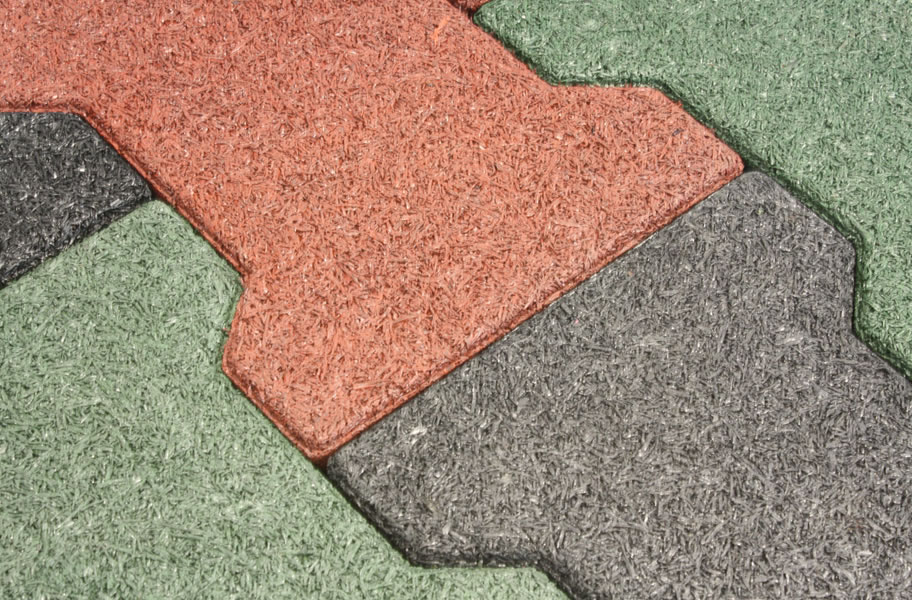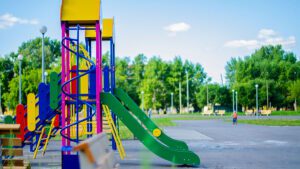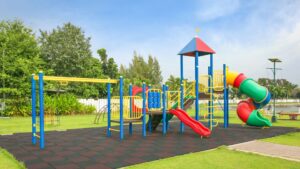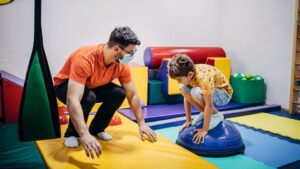Designing a commercial indoor playground involves more than selecting colorful play structures and slides—it starts from the ground up. The right flooring not only enhances the look and feel of your play area but also ensures safety, noise reduction, and ease of maintenance. This guide explores seven leading flooring solutions, compares their pros and cons, and offers tips to help you choose the ideal surface for your facility.

1. Soft Foam Tiles
What They Are
Interlocking EVA (ethylene-vinyl acetate) foam tiles that cushion falls and come in vibrant colors and patterns.
Benefits
- Superior Impact Absorption: Cushions falls up to 2-3 feet.
- Customization: Mix and match colors, shapes, and edge trims.
- Quick Installation: Tiles snap together without adhesives.
- Easy Maintenance: Wipe clean with a damp mop or cloth.
Drawbacks
- Durability: May compress under heavy equipment or high foot traffic over time.
- Edge Security: Loose edges can curl if not properly installed.
Ideal Use Cases
Toddler zones, toddler play panels, soft-play obstacle areas.

2. Poured-In-Place Rubber
What It Is
A seamless, two-layer system of bonded rubber granules poured on-site over a shock-absorbing cushion.
Benefits
- Custom Thickness & Colors: Tailor shock absorption (1–3 inches) and shade options.
- Seamless Surface: Eliminates trip hazards.
- Slip Resistance: Ideal for zones with water features or splash pads.
- Longevity: UV– and stain–resistant for 8–12 years.
Drawbacks
- Upfront Cost: Higher initial investment and professional installation required.
- Curing Time: Requires 24–48 hours before play can resume.
Ideal Use Cases
High-traffic play fields, under climbing frames, near water play areas.

3. Rubber Padding Rolls (Mat-Flex)
What They Are
Pre-fabricated rubber mats cut to size, often made from recycled tire granules bonded with polyurethane.
Benefits
- Shock Absorption: Excellent fall protection for common play heights.
- Noise Dampening: Reduces echo and footstep noise.
- Quick Replaceability: Damaged sections can be swapped without replacing entire floor.
- Cost-Effective: Lower installation cost than poured rubber.
Drawbacks
- Seams Visible: Requires precision to minimize trip hazards.
- Edge Sealing: Needs trim or adhesive to secure borders.
Ideal Use Cases
Under swings, around play structures, multi-use activity zones.

4. Artificial Turf
What It Is
Synthetic grass fiber tufted into a backing with an infill layer (rubber granules or sand) to cushion falls.
Benefits
- Low Maintenance: No mowing or watering; occasional brushing or vacuuming.
- Aesthetics: Creates outdoor-indoor feel, vibrant green year-round.
- Durability: Can withstand heavy foot traffic and sensorial play.
- Drainage: Some systems allow water play and easy cleaning.
Drawbacks
- Surface Hardness: Requires adequate infill depth for safe shock absorption.
- Hygiene Concerns: Needs regular sanitation to prevent mold or odors.
Ideal Use Cases
Sports play areas, “lawn” zones for imaginative games, roller-skate spaces.

5. Vinyl Sheet & Tile Flooring
What It Is
Resilient, commercial-grade vinyl in rolls or interlocking tiles, often with cushioned backing.
Benefits
- Easy Cleaning: Wipe away spills, sanitize with standard cleaners.
- Design Variety: Printed patterns, wood or stone looks, bright colors.
- Water Resistance: Ideal for snack areas or near bathroom entrances.
- Cost-Effective: Lower material and installation expense.
Drawbacks
- Moderate Cushioning: Less impact protection unless paired with foam underlayment.
- Seam Care: Requires professional seams to avoid lifting in high-traffic areas.
Ideal Use Cases
Entryways, party rooms, café seating zones adjacent to play areas.

6. Interlocking Rubber Pavers
What They Are
Heavy-duty rubber blocks with tongue-and-groove joints, often made from recycled materials.
Benefits
- Durable & Replaceable: Individual tiles swap out easily.
- Heavy Load Capacity: Supports vending machines, benches, and arcade equipment.
- Noise Control: Thick rubber dampens sound effectively.
- Slip Resistance: Textured surface reduces trip and slip risk.
Drawbacks
- Comfort: Firmer underfoot compared to poured or foam options.
- Installation: Blocks must be cut and laid precisely for a flush finish.
Ideal Use Cases
Arcade game sections, seating areas with heavy furniture, electronics zones.

7. Cork Flooring
What It Is
Heat-compressed cork tiles or planks sealed with a protective finish.
Benefits
- Eco-Friendly: Renewable natural resource.
- Soft Cushioning: Shock-absorbing without chemical odors.
- Thermal Insulation: Wood-like warmth underfoot.
- Sound Dampening: Reduces echo in high-ceilinged indoor playgrounds.
Drawbacks
- Moisture Sensitivity: Must be sealed and maintained to prevent damage.
- Scratch Prone: Can dent under heavy loads or sharp objects.
Ideal Use Cases
Quiet reading nooks, yoga and toddler sensory zones.

Key Selection Criteria
When choosing playground flooring, balance these factors:
- Safety Standards: Confirm ASTM or EN 1177 compliance for impact attenuation.
- Age Group: Toddlers need softer foam; teens can handle firmer surfaces.
- Traffic Volume: High-traffic areas demand durable rubber or turf solutions.
- Maintenance Capacity: Consider in-house cleaning vs. professional services.
- Budget Constraints: Factor both initial installation and lifecycle maintenance costs.
- Theme & Aesthetics: Match flooring color and pattern to brand identity and play themes.
Installation & Maintenance Tips
- Professional Assessment: Engage a flooring specialist to evaluate subfloor condition and recommend underlayments.
- Regular Cleaning Schedule: Daily sweeping and weekly mopping or vacuuming prevents debris build-up.
- Periodic Safety Audits: Monthly impact-attenuation testing and quarterly seam inspections catch wear early.
- Spot Repairs: Keep spare tiles or pavers on-site for quick replacement of damaged sections.
- Protective Sealants: Re-seal vinyl or cork floors as per manufacturer’s guidelines to extend life.

Conclusion
Selecting the best flooring for commercial indoor playgrounds requires assessing safety, durability, maintenance, and aesthetic needs. From soft foam tiles perfect for toddlers to poured-in-place rubber that stands up to heavy use, each flooring type has unique advantages. By aligning your choice with the specific zones—climbing areas, ball pits, snack zones—you’ll create a play environment that’s not only eye-catching but also secure and long-lasting.
Invest wisely in quality flooring, and your playground will remain a safe, engaging, and profitable destination for families for years to come.




